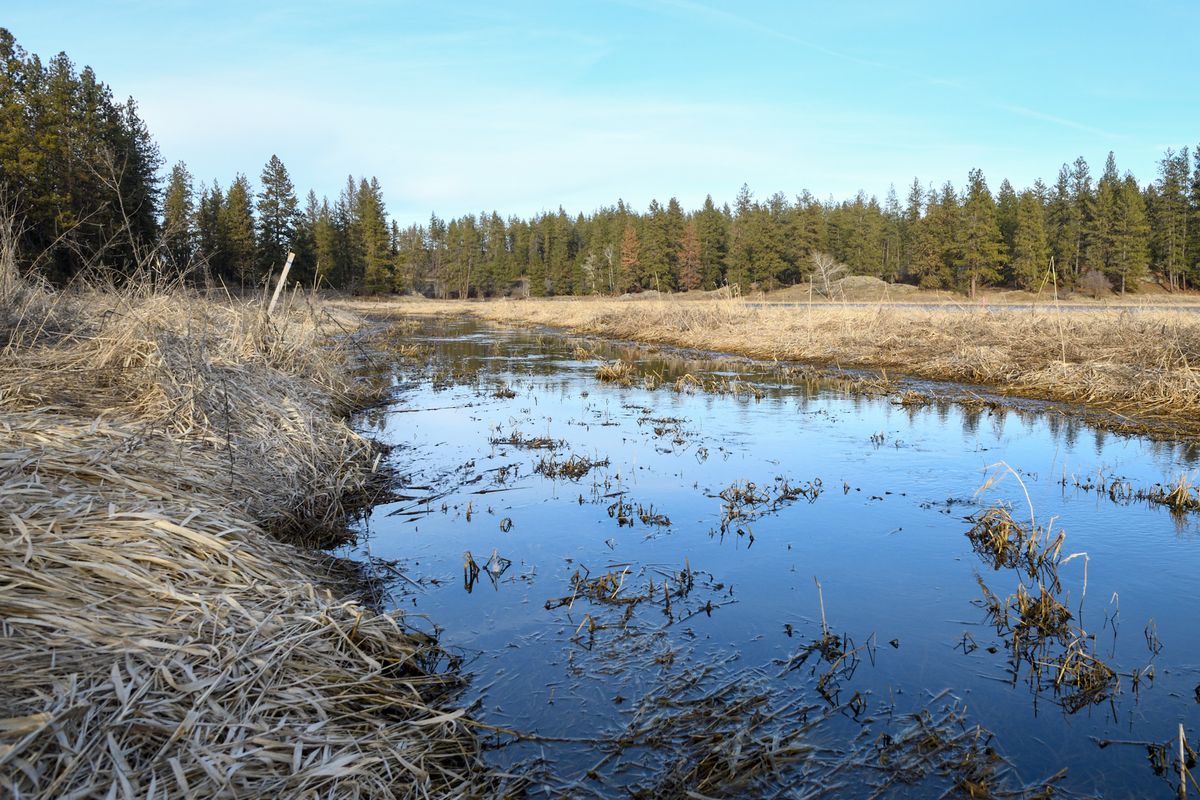Wetland, ho! Spokane County to spend $769k mitigating impacts of Bigelow Gulch Road project

The cottonwoods and shrubs make it almost invisible, but the creek is down in the gully, by the side of the road, past the stray hubcaps and weather-beaten Pabst Blue Ribbon cans.
For years, the waters of Bigelow Gulch Creek have sustained a wetland along this steep curve of Bigelow Gulch Road near Orchard Prairie. But the wetland’s days are numbered.
After more than two decades of planning and construction, Spokane County is nearing the end of its massive $75 million Bigelow Gulch Road project. Civil engineers say, that by reducing curves and adding lanes, the county can make the road safer and better equipped to handle traffic between north Spokane and Spokane Valley.
Straightening out curves means rerouting the road, however. The wetland is in the way, and soon to be partially paved over. A new one is taking its place, though.
The Spokane County Commission last week unanimously approved $769,000 in funding for a Bigelow Gulch Road wetland mitigation project. The county will soon create or enhance 7.2 acres of wetland near Fish Lake, off of the Columbia Plateau Trail.
Today, the county’s mitigation site is little more than a grassy field sandwiched between Union Pacific and BNSF railroad tracks. Minnie Creek cuts through the field’s western edge. A giant puddle covers much of the northeast corner.
The mitigation project will transform the land. A county contractor will place boulder clusters, root wads, logs and beaver dam analogs – mankind’s attempt to imitate the industrious rodent – in Minnie Creek to slow down and spread out the water.
In addition to disrupting the flow of the creek, the contractor will plant more than 1,300 cottonwoods, willows, hawthorns, currant bushes, aspens and wood’s rose. Rushes, sedges, yarrow, lupine and arrowleaf also will be planted.
Three quarters of a million dollars is a lot of money for a local government to spend creating a wetland. However, Spokane County had no choice but to mitigate the impact of its Bigelow Gulch Road project.
Wetlands are protected by state and federal law. The Washington Department of Ecology tries to ensure that whenever a construction project damages or removes a wetland, the responsible party rehabilitates, preserves or creates another one – ideally within the same watershed.
“We want to protect the important functions that wetlands provide,” Department of Ecology Wetland Mitigation Specialist Patricia Johnson said.
Wetlands have great ecological significance and provide critical habitat for thousands of wildlife species. They also benefit humans in two primary ways.
They catch and store water, reducing the risk of floods. Removing a wetland can often lead to flooding or erosion.
“The water has to go someplace,” Johnson said. “That someplace may be in somebody’s basement, or it could be over a road or some other kind of infrastructure, or it could just be flowing very quickly into a ditch, a creek, a stream.”
Wetlands also act as natural filters, sucking up pollutants and excessive nutrients that could otherwise end up in rivers or oceans.
While Spokane County had to mitigate the impact to wetlands along Bigelow Gulch Road, it didn’t have to create one from scratch. The county could have bought credits and preserved an existing wetland.
But Spokane County bought its 50-acre, $245,000 property with wetland mitigation in mind. The county may expand the site to offset future impacts to wetlands.
Construction on the mitigation project is set to begin this fall, according to county planning documents.
Editor’s note: This story has been updated to remove incorrect information about the source of Minnie Creek.